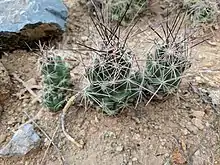Coryphantha macromeris
Coryphantha macromeris, the nipple beehive cactus,[1] is a species of cactus in the United States and Mexico. In the Chihuhuan Desert, it is common and has a wide range.[2] In the United States, it occurs naturally in Texas and New Mexico.[1] It prefers to grown in the shade under other larger plants, growing in irregular clusters or mounds.[3][4] In late summer, it blooms with purple or pink flowers and then bears green fruit.[3][4]
| Coryphantha macromeris | |
|---|---|
 | |
| Scientific classification | |
| Kingdom: | Plantae |
| Clade: | Tracheophytes |
| Clade: | Angiosperms |
| Clade: | Eudicots |
| Order: | Caryophyllales |
| Family: | Cactaceae |
| Subfamily: | Cactoideae |
| Genus: | Coryphantha |
| Species: | C. macromeris |
| Binomial name | |
| Coryphantha macromeris (Engelm.) Lem. | |
Biochemistry
The phenethylamine macromerine is present in the cactus.[5]
References
- "Plants Profile for Coryphantha macromeris (nipple beehive cactus)". Plants Database. USDA. Retrieved 2017-09-08.
- IUCN (2009). "Coryphantha macromeris: Heil, K., Terry, M., Corral-Díaz, R., Lüthy, A.D. & Dicht, R.F." IUCN Red List of Threatened Species. doi:10.2305/iucn.uk.2013-1.rlts.t152811a681352.en.
- Loflin, Brian; Loflin, Shirley (2009). Texas Cacti. Texas A&M University Press. p. 133. ISBN 9781603443685.
- "Coryphantha macromeris, nipple beehive cactus". The American Southwest. Retrieved 2017-09-08.
- Brown, Stanley D.; Hodgkins, Joe E.; Reinecke, Manfred G. (1972). "Isolation, structure, synthesis, and absolute configuration of the cactus alkaloid, macromerine". The Journal of Organic Chemistry. 37 (5): 773–5. doi:10.1021/jo00970a024. PMID 5016327.
This article is issued from Wikipedia. The text is licensed under Creative Commons - Attribution - Sharealike. Additional terms may apply for the media files.
